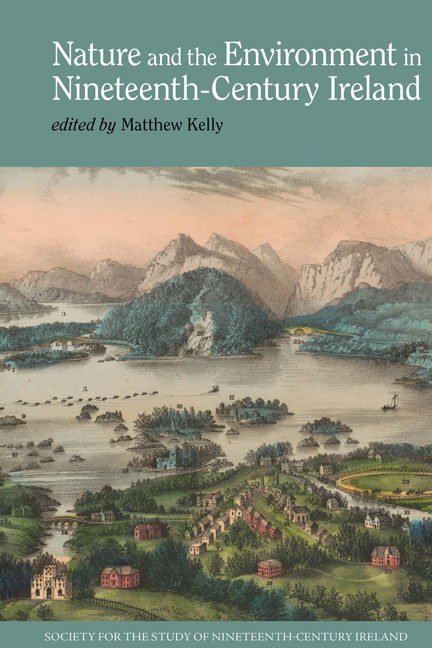Book contents
- Frontmatter
- Contents
- Acknowledgements
- List of Figures
- List of Tables
- List of Contributors
- Introduction
- 1 The Nature of Improvement in Ireland
- 2 Palmerston’s Conquest of Sligo
- 3 ‘A Voice for Ireland’: Isaac Butt, Environmental Justice, and the Dilemmas of the Irish Land Question
- 4 ‘In the Open Country’: Nature and the Environment during the ‘Monster’ Meeting Campaign of 1843
- 5 Therapeutic Environments in Nineteenth-Century Ireland: Hybrid Spaces and Practices
- 6 On Why the UK’s First National Park Might Have Been in Ireland
- 7 Towards an Environmental History of Nineteenth-Century Dublin
- 8 Mainstream or Tributary? The Question of ‘Hibernian’ Fishes in William Thompson’s The Natural History of Ireland (1849–56)
- 9 The Ocean of Truth: Atlantic Imagery in Emily Lawless’s Major Lawrence, F.L.S. (1885) and Grania: The Story of an Island (1892)
- 10 Seumas O’Sullivan and Revivalist Nature Poetry
- Index
6 - On Why the UK’s First National Park Might Have Been in Ireland
- Frontmatter
- Contents
- Acknowledgements
- List of Figures
- List of Tables
- List of Contributors
- Introduction
- 1 The Nature of Improvement in Ireland
- 2 Palmerston’s Conquest of Sligo
- 3 ‘A Voice for Ireland’: Isaac Butt, Environmental Justice, and the Dilemmas of the Irish Land Question
- 4 ‘In the Open Country’: Nature and the Environment during the ‘Monster’ Meeting Campaign of 1843
- 5 Therapeutic Environments in Nineteenth-Century Ireland: Hybrid Spaces and Practices
- 6 On Why the UK’s First National Park Might Have Been in Ireland
- 7 Towards an Environmental History of Nineteenth-Century Dublin
- 8 Mainstream or Tributary? The Question of ‘Hibernian’ Fishes in William Thompson’s The Natural History of Ireland (1849–56)
- 9 The Ocean of Truth: Atlantic Imagery in Emily Lawless’s Major Lawrence, F.L.S. (1885) and Grania: The Story of an Island (1892)
- 10 Seumas O’Sullivan and Revivalist Nature Poetry
- Index
Summary
The UK government first gave serious thought to designating National Parks in 1929 when Ramsay MacDonald's Labour Government commissioned Christopher Addison to investigate the issue. His recommendations were received favourably in Whitehall, but their formal adoption was derailed by the economic crisis engulfing the country. The successor National Government paid lip service to Addison's proposals, but significant executive action was not taken. The issue was revisited during the Second World War and taken up by the Attlee governments. The National Parks Act 1949 established the National Parks Commission, which was empowered to designate National Parks in England and Wales. By 1957, ten were designated. Much of the drive for these designations came from access campaigners and it was no coincidence that the legislative steps were taken by a Labour government. National Park designation was as integral to the social democratic agenda as the creation of the National Health Service.
As is often the case in British history, a broadly accepted historical narrative is complicated if account is taken of Ireland. National Park history in the United Kingdom would look very different had lobbyists succeeded in persuading the government to purchase the Muckross Demesne in County Kerry and manage it as a National Park when it came on the market in 1899. The same might be said of the history of the National Trust, which launched a campaign to raise the funds to buy the estate. Such a large holding, dwarfing any other National Trust acquisition of the period, would have reorientated the geographical focus of the organization and given it a genuine British–Irish character. Either form of acquisition would also have positioned Ireland more prominently within two larger historical processes, namely what one historian has called ‘the dawn of green’ and others have characterized as the history of the nature state.
That the government refused to step in, and that the National Trust campaign made little headway, probably accounts for why this episode has been largely overlooked by historians. It deserves revisiting for a number of reasons. Most obviously, the question had political traction because the estate included much of what was generally considered the most charismatic landscape in Ireland and, according to many commentators, in the UK.
- Type
- Chapter
- Information
- Nature and the Environment in Nineteenth-Century Ireland , pp. 118 - 138Publisher: Liverpool University PressPrint publication year: 2019



